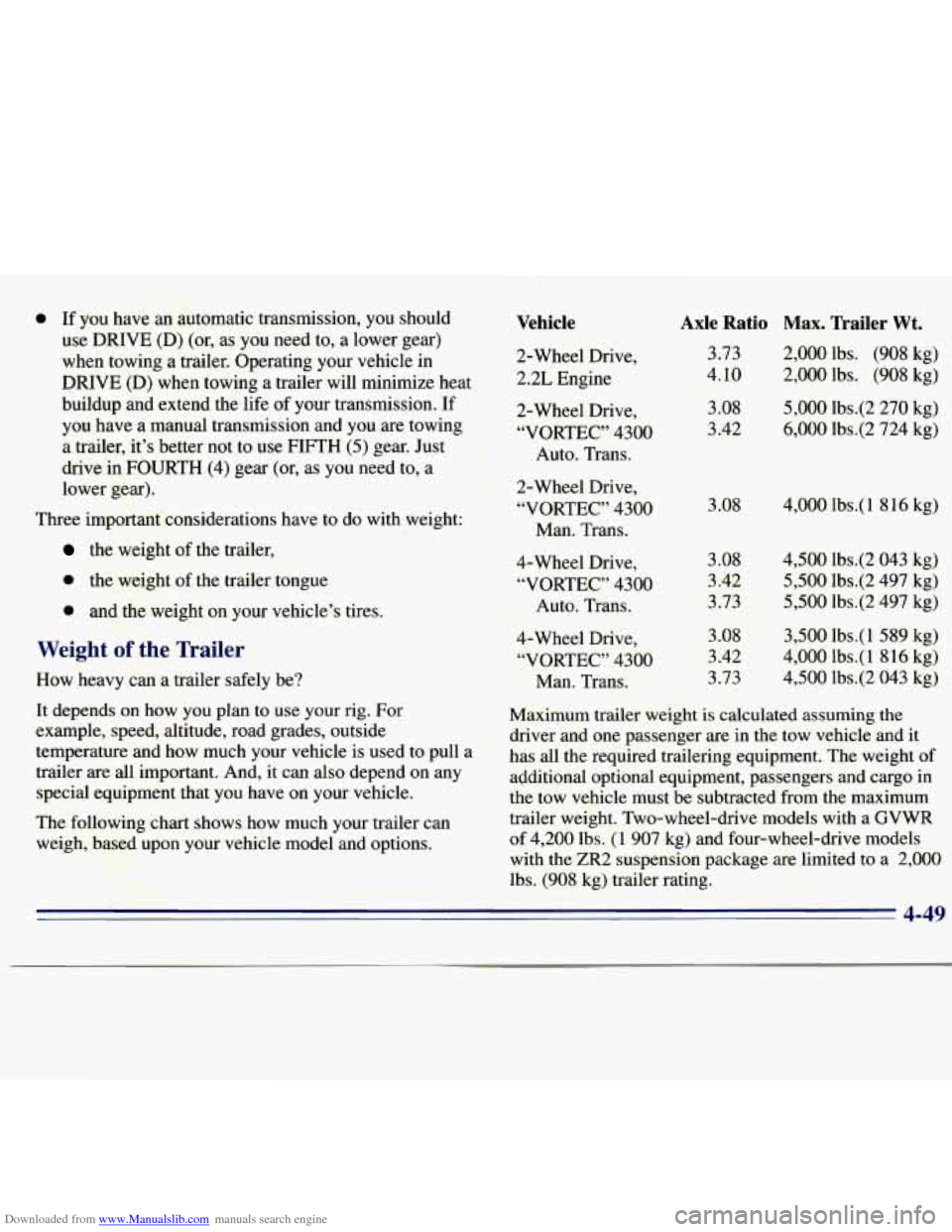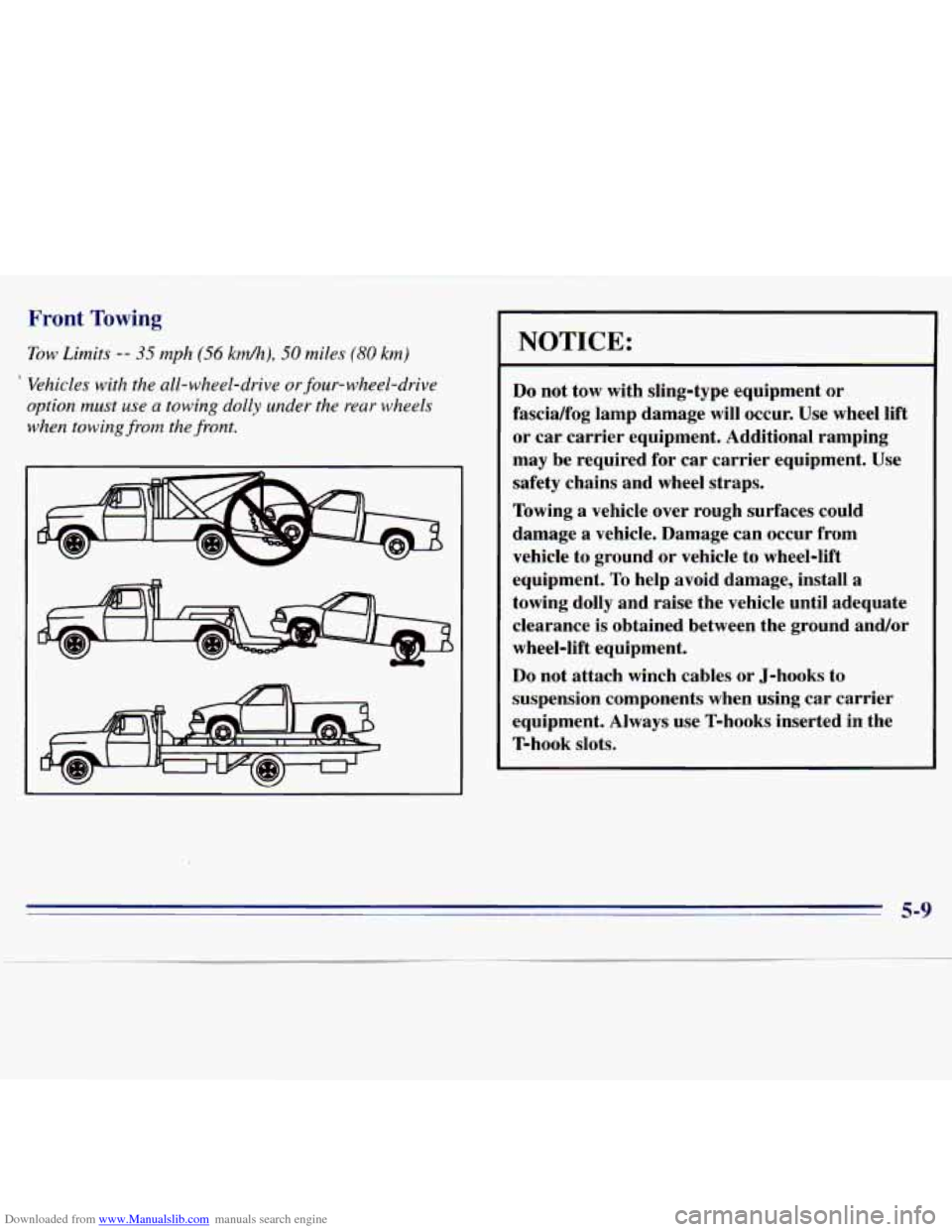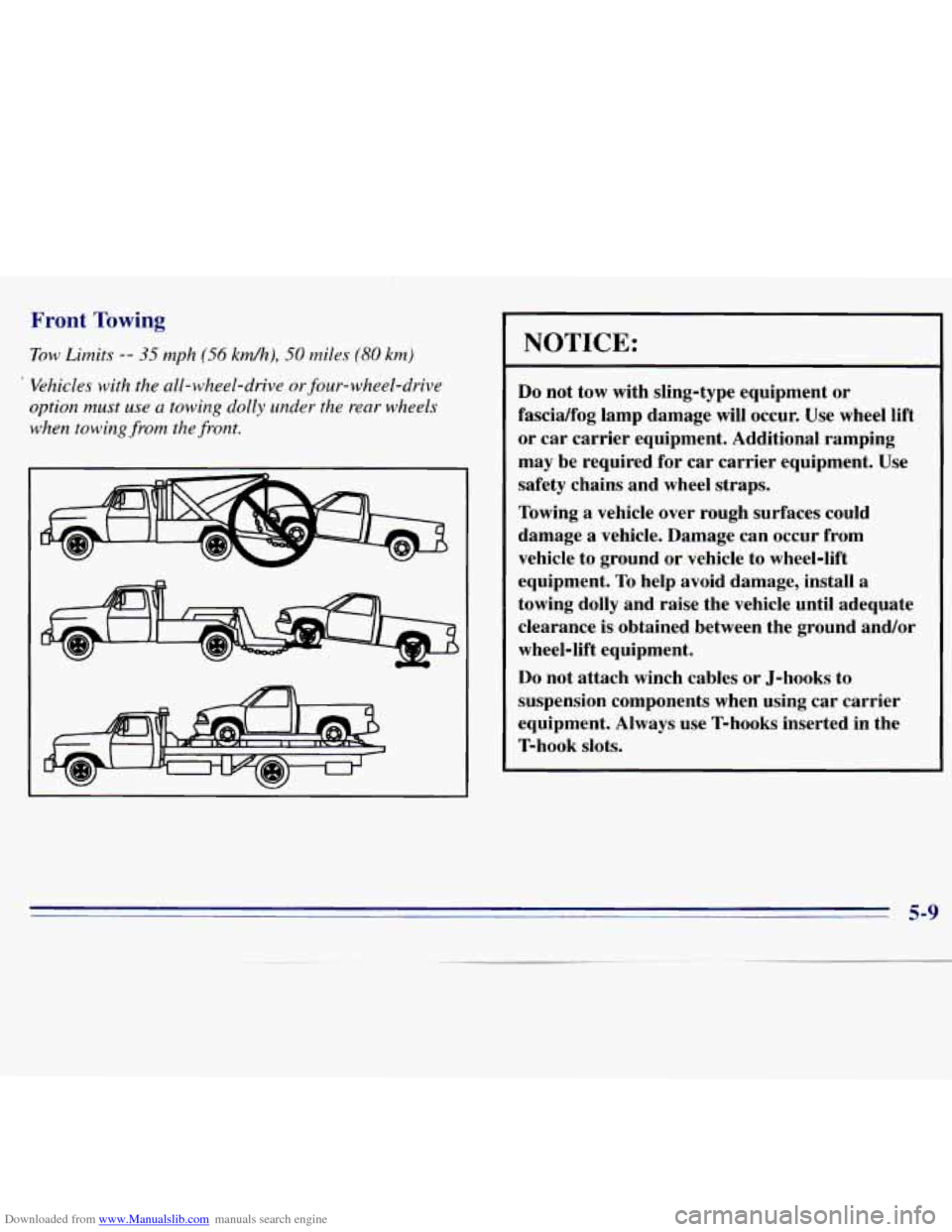1996 CHEVROLET S10 suspension
[x] Cancel search: suspensionPage 158 of 375

Downloaded from www.Manualslib.com manuals search engine If the water isn’t too deep, then drive through it slowly.
At fast speeds, water splashes
on your ignition system
and your vehicle can stall. Stalling can also occur if you
get your tailpipe under water. And, as long as your
tailpipe is under water, you’ll never be able to start your
engine. When
you go through water, remember that
when your brakes get wet, it may take you longer
to stop.
Driving through rushing water can be dangerous.
Deep water can sweep your vehicle downstream
and you and your passengers could drown.
If it’s
only shallow water, it can still wash away the
ground from under your tires, and you could lose
traction and roll the vehicle over. Don’t drive
through rushing water.
See “Driving Through Water” in the Index for more
information on driving through water.
After Off-Road Driving
Remove any brush or debris that has collected on the
underbody, chassis or under the hood. These
accumulations
can be a fire hazard.
After operation in mud
or sand, have the brake linings
cleaned and checked. These substances can cause
glazing and uneven bralung. Check the body structure,
steering, suspension, wheels, tires and exhaust system
for damage. Also, check the fuel lines and cooling
system for any leakage.
Your vehicle will require more frequent service due to
off-road use. Refer to the Maintenance Schedule for
additional information.
4-27
Page 174 of 375

Downloaded from www.Manualslib.com manuals search engine ’ A CAUTIGA:
Do not load your vehicle any heavier than the
GVWR, or either the maximum front or rear
GAWR.
If you do, parts on your vehicle can
break, or it can change the
way your vehicle
handles. These could cause you to lose control.
Also, overloading can shorten the life of
your vehicle.
Using heavier suspension components to get added
durability might
not change your weight ratings. Ask
your dealer
to help you load your vehicle the right way.
NOTICE:
Your warranty does not cover parts or
components that fail because
of overloading. If
you put
things inside your vehicle -- like suitcases,
tools, packages, or anything else
-- they will go as fast
as the vehicle goes. If
you have to stop or turn quickly,
or
if there is a crash, they’ll keep going.
Things you put inside your vehicle can strike
and injure people in a sudden stop or turn, or in
a crash.
0 Put things in the cargo area of your vehicle.
0 Never stack heavier things, like suitcases,
Try to spread the weight evenly.
inside the vehicle
so that some of them are
above the tops
of the seats.
0 Don’t leave an unsecured child restraint in
your vehicle.
When you carry something inside the
vehicle, secure it whenever you can.
There’s also important loading information for off-road
driving in this manual. See “Loading Your Vehicle” in
the Index.
Page 180 of 375

Downloaded from www.Manualslib.com manuals search engine 0 If you haw a11 automatic transmission, you should Vehicle Axle Ratio Max. Trailer Wt.
use DRIVE (D) (or, as you need to, a lower gear)
when towing a trailer. Operating your vehicle in 2-Wheel Drive,
DRIVE (D) when towing a trailer will minimize heat 2.Z Engine 3.73 2,000
lbs. (908 kg)
4.10 2,000 lbs. (908 kg)
buildup and extend the life
of your transpission. If 2-Wheel Drive, 3.08 5,000 lbs.(2 270 kg)
you have a manual transmission and you are towing
“VORTEC” 4300 3.42 6,000 lbs.(2 724 kg)
a trailer, it’s better not to use
FIFTH (5) gear. Just Auto. Trans.
drive in
FOURTH (4) gear (or, as you need to, a -
lower gear). pi,. 2-Wheel Drive,
“-“‘VORTEC” 4300 3.08 4,000 lbs.( 1 816 kg)
Three important considerations have to do with weight:
Man. Trans. ,I+, : = . -
the weight of the trailer,
0 the weight of the trailer tongue
0 and the weight on your vehicle’s tires.
Weight of the Trailer
How heavy can a trailer safely be? 4-Wheel Drive,
3.08 4,500
lbs.(2 043
kg)
“VORTEC” 4300 3.42
5,500 lbs.(2 497 kg)
Auto. Trans. 3.73
5,500 lbs.(2
497 kg)
4-Wheel Drive, 3.08 3,500
lbs.( 1 589 kg)
“VORTEC” 4300 3.42
4,000 lbs.( 1 816
kg)
Man. Trans. 3.73
4,500 lbs.(2 043 kg)
It depends
on how you plan to use your rig. For
Maximum trailer weight is calculated assuming the
example, speed, altitude, road grades, outside
driver and one passenger are in the tow vehicle and it
temperature and how Your vehicle is used to Pull a
’ has all the required trailering equipment. The weight of
trailer are all important. And, it can also depend on any
agditional optional equipment, passengers and cargo in
special equipment that you have on your vehicle.
the tow vehicle must be subtracted from the maximum
The following chart shows how much your trailer can trailer weight. Two-wheel-drive models
with a GVWR
weigh, based upon your vehicle model and options. of
4,200 lbs.
(1 907 kg) and four-wheel-drive models
JT”;’ ,-p?? , ,- -&-I:. , * with the ZR2 suspension package are limited to a 2,000
’ , :-qqg$+. r *? *. F:. rr I‘
ty+ : ‘ -.. 4 I lbs. (908 kg) trailer rating.
4-49
Page 197 of 375

Downloaded from www.Manualslib.com manuals search engine mm
A vehicle can fall from a car carrier if it isn’t
adequately secured, This can cause a collision,
serious personal injury and vehicle damage. The
vehicle should be tightly secured with chains or
steel cables before
it is transported.
Don’t use substitutes (ropes, leather straps,
canvas webbing, etc.) that can be cut by sharp
edges underneath the towed vehicle. Always use
T-hooks inserted in the T-hook slots, Never use
J-hooks. They will damage drivetrain and
suspension components, When your vehicle
is being towed, have the ignition key
turned
to the OFF position. The steering wheel should
be clamped in a straight-ahead position with a clamping device designed for towing service.
Do not use the
vehicle’s steering column lock for this. The transmission
should be in
NEUTRAL (N) and the transfer case, if
you have one, should be in 2HI. The parking brake
should be released.
Don’t have your vehicle towed on the drive wheels
unless you must.
If the vehicle must be towed on the
drive wheels, be sure to follow the speed and distance
restrictions later in this section or your transmission will
be damaged. If these limitations must be exceeded, then
the drive wheels have
to be supported on a dolly.
5-8
Page 198 of 375

Downloaded from www.Manualslib.com manuals search engine Front Towing
Tow Limits -- 35 mph (56 km/h), 50 miles (80 km)
' Vehicles with the all-wheel-drive or.four- wheel-drive
option must
use a towing dolly under the rear wheels
when towing
from the front.
NOTICE:
Do not tow with sling-type equipment or
fascidfog lamp damage will occur. Use wheel lift
or car carrier equipment. Additional ramping
may be required for car carrier equipment. Use
safety chains and wheel straps.
Towing a vehicle over rough surfaces could
damage
a vehicle. Damage can occur from
vehicle to ground or vehicle to wheel-lift
equipment.
To help avoid damage, install a
towing dolly and raise the vehicle until adequate
clearance is obtained between the ground and/or
wheel-lift equipment.
Do not attach winch cables or J-hooks to
suspension components when using car carrier
equipment. Always use T-hooks inserted
in the
T-hook slots.
5-9
Page 199 of 375

Downloaded from www.Manualslib.com manuals search engine Front Towing
Tow Limits -- 35 mph (56 km/h), 50 miles (80 km)
' Vehicles with the all-wheel-drive or four-wheel-drive
option must
use a towing dolly under the rear wheels
when towing
from the front.
NOTICE:
Do not tow with sling-type equipment or
fascia/fog lamp damage will occur. Use wheel lift
or car carrier equipment. Additional ramping
may be required for car carrier equipment. Use
safety chains and wheel straps.
Towing
a vehicle over rough surfaces could
damage
a vehicle. Damage can occur from
vehicle to ground or vehicle to wheel-lift
equipment.
To help avoid damage, install a
towing dolly and raise the vehicle until adequate
clearance is obtained between the ground and/or
wheel-lift equipment.
Do not attach winch cables or J-hooks to
suspension components when using car carrier
equipment. Always use T-hooks inserted in the
T- hook slots.
5-9
Page 200 of 375

Downloaded from www.Manualslib.com manuals search engine Rear Towing
Tow Limits -- 35 mph (56 km/h), 50 miles (80 km)
Vehicles with the ail-wheel-drive
or four- wheel-drive
option must use
a towing dolly under the front wheels
when towing from the real:
NOTICE:
Do not tow with sling-type equipment or rear
bumper valance damage will occur. Use wheel lift
or car carrier equipment. Additional ramping.
may be required for car carrier equipment. Use
safety chains and wheel straps.
Towing a vehicle over rough surfaces could
damage a vehicle. Damage can occur from
vehicle to ground or vehicle to wheel-lift
equipment. To help avoid damage, install a
towing dolly and raise the vehicle until adequate
clearance is obtained between the ground and/or
wheel-lift equipment.
Do not attach winch cables or J-hooks to
suspension components when using car carrier
equipment. Always use T-hooks inserted
in the
T-hook slots.
5-10
Page 303 of 375

Downloaded from www.Manualslib.com manuals search engine I Short TripKity Maintenance Schedule I
3,000 Miles (5 000 km)
0 Change engine oil and filter (or every
3 months, whichever occurs first).
An Emission Control Service.
0 Lubricate the front suspension, ball joints,
steering linkage and transfer case shift
linkage, parking brake cable guides,
propshaft splines, universal joints, brake
pedal springs and clutch pedal springs at
every oil change (or every
3 months,
whichever occurs first).
0 Check readfront axle fluid level and add
fluid as needed. Check constant velocity
joints and axle seals for leaking.**
6,000 Miles (10 000 km)
0 Change engine oil and filter (or every
3 months, whichever occurs first).
An Emission Control Service.
0 Lubricate the front suspension, ball joints,
steering linkage and transfer case shift
linkage, parking brake cable guides,
propshaft splines, universal joints, brake
pedal springs and clutch pedal springs at
every oil change (or every
3 months,
whichever occurs first).
Check readfront axle fluid level and add
fluid
as needed. Check constant velocity
joints and axle seals for lealung.
**
(Continued)
7-7